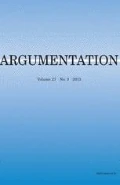Abstract
This article examines argument structures and strategies in pro and con argumentation about the possibility of human-level artificial intelligence (AI) in the near term future. It examines renewed controversy about strong AI that originated in a prominent 1999 book and continued at major conferences and in periodicals, media commentary, and Web-based discussions through 2002. It will be argued that the book made use of implicit, anticipatory refutation to reverse prevailing value hierarchies related to AI. Drawing on Perelman and Olbrechts-Tyteca's (1969) study of refutational argument, this study considers points of contact between opposing arguments that emerged in opposing loci, dissociations, and casuistic reasoning. In particular, it shows how perceptions of AI were reframed and rehabilitated through metaphorical language, reversal of the philosophical pair ‘artificial/natural,’ appeals to the paradigm case, and use of the loci of quantity and essence. Furthermore, examining responses to the book in subsequent arguments indicates the topoi characteristic of the rhetoric of technology advocacy.
Similar content being viewed by others
REFERENCES
Anonymous: 2000 (April), ‘A Pattern of Success’ Scientific American 282, 47.
Anonymous: 2002a (16 March), ‘AI by Another Name’ The Economist. Retrieved 2 Sept. 2002 from LexisNexis.
Anonymous: 2002b (2 April), ‘summary of Symposium on Spiritual Machines’ Slashdot. Retrieved 16 Aug 2001 from http://www.slashdot.org/features/00/04/01/2121226.shtml.
‘Are We Becoming an Endangered Species? Technology and Ethics in the Twenty-First Century’: 2001 (19 Nov.), Panel Discussion November 19, 2001, at the Washington National Cathedral, Washington DC. Retrieved 30 Sept. 2002 from http://www.kurzweilai. net/meme/frame.html?m=2.
‘Artificial’: 1989, Oxford English Dictionary, Clarendon Press, Oxford. Retrieved 29 Sept. 2002 from http://dictionary.oed.com/cgi/entry/00012569.
Copeland, B. J.: 2002, ‘Artificial Intelligence’ Encyclopaedia Britannica. Retrieved 30 Aug. 2002 from http://www.search.eb.com/eb/article?eu=410253.
Crevier, D.: 1993, AI: The Tumultuous History of the Search for Artificial Intelligence, Basic Books, New York.
Czubaroff, J.: ‘The Public Dimension of Scientific Controversies’ Argumentation 11, 51–74.
Dembski, W. A.: 2002, ‘Kurzweil's Impoverished Spirituality’ in J. W. Richards (ed.), Are We Spiritual Machines: Ray Kurzweil vs. the Critics of Strong AI, Discovery Institute Press, Seattle, WA. Retrieved 8 Sept. 2002 from http://www.kurweilai.net/meme/ frame.html?main=/articles/art0497.html.
Dreyfus, H. L. and S. E. Dreyfus: 1988, ‘Making a Mind Versus Modeling the Brain: Artificial Intelligence Back at a Branchpoint’ in S. R. Groubard (ed.), The Artificial Intelligence Debate: False Starts, Real Foundations, MIT Press, Cambridge, MA, 15–43.
Drozdek, A.: 1994, ‘Response to “The Possibility of Computers Becoming Persons”’ Social Epistemology 8, 177–197.
Edwards, P. N.: 1996, The Closed World: Computers and the Politics of Discourse in Cold War America, MIT Press, Cambridge, MA.
Fahnestock, J.: 1999, Rhetorical Figures in Science, Oxford University Press, New York.
Fearn, N.: 1999 (17 April), ‘Silicon Chips with Everything?’ The Spectator 282, 38–39.
Witness@Second_Millennium.FemaleMan © _Meets_ OncoMouse TM}, Routledge, New York.
Hayles, N. K.: 1999, How We Became Posthuman: Virtual Bodies in Cybernetics, Literature, and Informatics, University of Chicago Press, Chicago.
International Society for Complexity, Information, and Design: 2001 (19 July), ‘Live Moderated Chat: Are We Spiritual Machines?’ Retrieved 11 Sept. 2002 from http://www.kurzweilai.net/meme/frame.html?m=17.
Jonsen, A. R. and S. Toulmin: 1988, The Abuse of Casuistry: A History of Moral Reasoning, University of California Press, Berkeley, CA.
Joy, B.: 2000 (April), ‘Why the Future Doesn't Need Us’ Wired 8, 238–246, 248-263.
Killheffer, R. K. J.: 1999 (Oct.-Nov.) ‘The Age of Spiritual Machines/Robot: Mere Machine to Transcendent Mind/Greetings, Carbon-Based Bipeds!’ Fantasy and Science Fiction 97, 36–46.
Kurzweil, R.: 1999, The Age of Spiritual Machines: When Computers Exceed Human Intelligence, Penguin Putnam, New York.
culture/Kurzweil/Kurzweil_print.html.
Lanier, J.: 2000 (25 Sept.), ‘One Half of a Manifesto’ Edge.org. Retrieved 16 Aug. 2001 from http://www.edge.org/documents/archive/edge74.html.
Lyne, J.: 1994, ‘Social Epistemology as a Rhetoric of Inquiry’ Argumentation 8, 111–124.
McGinn, C.: 1999 (3 Jan.), ‘Hello Hal’ New York Times Book Review 7, 11–12.
Miller, C. R.: 1994, ‘Opportunity, Opportunism, and Progress: Kairos in the Rhetoric of Technology’ Argumentation 8, 81–96.
Mundy, T.: 2000 (Aug.-Sept.), ‘The Edge of Science’ Prospect, cited at Edge.org. Retrieved 16 Aug. 2001 from http://www.edge.org/documents/archive/edge74.html.
Olbrechts-Tyteca, L.: 1979, ‘Les Couples philosophiques: Une nouvelle approche’ Revue internationale de philosophie 33, 81–98.
Perelman, C. and L. Olbrechts-Tyteca: 1969, The New Rhetoric: A Treatise on Argumentation (J. Wilkerson and P. Weaver, trans.), University of Notre Dame Press, Notre Dame, IN.
Proudfoot, D.: 1999 (30 April), ‘How Human Can They Get?’ Science 284, 745.
Reeke, G. N. and G. M. Edelman: 1988, ‘The New Connectionalism: Developing Relationships between Neuroscience and Artificial Intelligence’ in S. R. Groubard (ed.), The Artificial Intelligence Debate: False Starts, Real Foundations, MIT Press, Cambridge, MA, 123–141.
Richards, J. W. (ed.): 2002, Are We Spiritual Machines: Ray Kurzweil vs. the Critics of Strong AI, Discovery Institute Press, Seattle, WA.
Rochlin, G. I.: 1997, Trapped in the Net: The Unanticipated Consequences of Computerization, Princeton University Press, Princeton, NJ.
Selfridge, O. G.: 1999 (Sept.-Oct.), ‘Approaching the Bionic Age’ Psychology Today 32, 66–68.
manifesto.html.
Vaux, J.: 2001, ‘From Expert Systems to Knowledge-Based Companies: How the AI Industry Negotiated a Market for Knowledge’ Social Epistemology 15, 231–245.
‘Will Spiritual Robots Replace Humanity by 2100?’: 2000. Retrieved 16 Aug. 2001. from http://www.stanford.edu/dept/symbol/Hofstadter-event.html.
Author information
Authors and Affiliations
Rights and permissions
About this article
Cite this article
Warnick, B. Rehabilitating AI: Argument Loci and the Case for Artificial Intelligence. Argumentation 18, 149–170 (2004). https://doi.org/10.1023/B:ARGU.0000024023.55226.59
Issue Date:
DOI: https://doi.org/10.1023/B:ARGU.0000024023.55226.59


